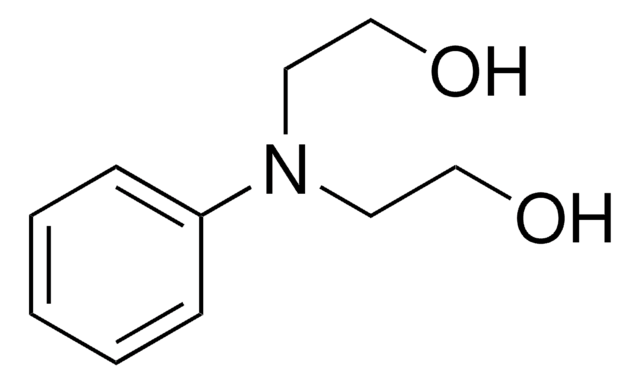14889
2,2′-(4-Methylphenylimino)diethanol
≥97.0% (NT)
Sinonimo/i:
2,2′-(p-Tolylimino)diethanol, N,N-Bis(2-hydroxyethyl)-p-toluidine, N-(p-Tolyl)diethanolamine
About This Item
Prodotti consigliati
Saggio
≥97.0% (NT)
Stato
solid
P. ebollizione
338-340 °C (lit.)
Punto di fusione
49-53 °C (lit.)
Gruppo funzionale
amine
hydroxyl
Stringa SMILE
Cc1ccc(cc1)N(CCO)CCO
InChI
1S/C11H17NO2/c1-10-2-4-11(5-3-10)12(6-8-13)7-9-14/h2-5,13-14H,6-9H2,1H3
JUVSRZCUMWZBFK-UHFFFAOYSA-N
Cerchi prodotti simili? Visita Guida al confronto tra prodotti
Categorie correlate
Applicazioni
Avvertenza
Avvertenze
Danger
Indicazioni di pericolo
Consigli di prudenza
Classi di pericolo
Acute Tox. 4 Oral - Aquatic Chronic 3 - Eye Dam. 1 - Skin Sens. 1
Codice della classe di stoccaggio
11 - Combustible Solids
Classe di pericolosità dell'acqua (WGK)
WGK 3
Punto d’infiammabilità (°F)
Not applicable
Punto d’infiammabilità (°C)
Not applicable
Dispositivi di protezione individuale
dust mask type N95 (US), Eyeshields, Gloves
Scegli una delle versioni più recenti:
Possiedi già questo prodotto?
I documenti relativi ai prodotti acquistati recentemente sono disponibili nell’Archivio dei documenti.
I clienti hanno visto anche
Il team dei nostri ricercatori vanta grande esperienza in tutte le aree della ricerca quali Life Science, scienza dei materiali, sintesi chimica, cromatografia, discipline analitiche, ecc..
Contatta l'Assistenza Tecnica.

















